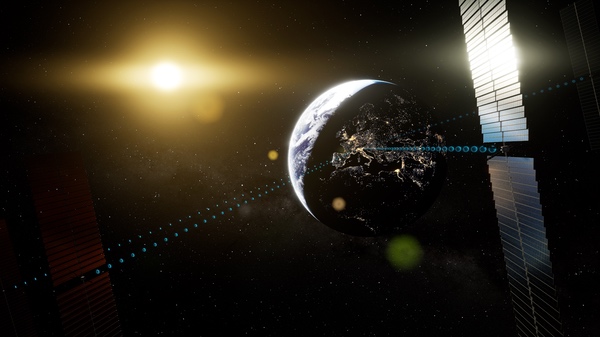Evaluating America’s green energy options including astroelectricity (part 4)by Mike Snead
|
| As White noted, “no culture can develop beyond the limits of its energy resources”. Humanity is at such a limit with our current substantial dependence on non-sustainable fossil fuels. |
After perhaps 200,000 years of hand-to-mouth dependency on hunting and gathering to survive, 11,000 years ago our ancestors invented the technological means to harness solar energy to produce an abundance of renewable energy called food. Over time, these technologies spread worldwide, enabling humanity to flourish and grow. Just three centuries ago, the means to convert solar energy stored in the form of fossil carbon fuels into useful mechanical power initiated an industrial cultural revolution that brought tremendous strides in improving the standard of living. Yet, much still needs to be done to elevate the world’s overall standard of living and globally share the benefits of this industrial culture.
As White noted, “no culture can develop beyond the limits of its energy resources”. Humanity is at such a limit with our current substantial dependence on non-sustainable fossil fuels. America and the world must undergo an orderly transition to abundant green energy if our temporarily prosperous industrial culture is to peacefully survive and end energy impoverishment worldwide—to achieve President Franklin D. Roosevelt’s “freedom from want”. Fortunately, there is broad global willingness to undertake this transition. Unfortunately, America and the world have not yet adopted a practicable technological path to achieve this goal.
The aim of this four-part article has been to quantitatively examine America’s options for how best to practicably go green. The following points summarize the key findings of the first three parts:
- America lacks but clearly needs a well-organized national energy security strategy—from an engineering perspective—to guide its orderly transition to green energy.
- With an orderly transition to green energy, America will still need a robust domestic fossil fuels industry to keep America energy secure and prosperous during the transition.
- Quantitative trade studies are needed to guide selecting a practicable path for America to transition to green energy.
- For Americans to have already gone green, each American would need a primary green electrical power supply sufficient to run 13–22 one-kilowatt countertop microwave ovens continuously.
- For America to have already gone green, America would need the equivalent of between 2,091–3,661 two-gigawatt Hoover Dams operating continuously.
- Scaling up nuclear fission power as a primary means of replacing fossil fuels is unwise and unlikely.
- The substantial scale of America’s needed new green energy infrastructure indicates that this will likely take most of the rest of the century to build.
- With continued net international migration to the United States, the US population will likely climb by about 50% to around 500 million by 2100.
- Wind power and ground solar power are not practicable options for America to go green.
To summarize these results, terrestrial nuclear fission power and the scalable terrestrial renewable power options of wind and ground solar cannot practicably enable America to go green. This leaves space solar power as the remaining scalable option for America to transition to the abundant green energy needed to remain a highly industrialized culture. (See Figure 1.)
 Figure 1: Scalable primary electricity options eliminated. By the process of elimination, space solar power-generated astroelectricity remains as America’s sole scalable option to go green. (Image sources: US government) |
Space solar power involves collecting sunlight in space, converting this solar power into electrical power, and transmitting this power to the ground to supply baseload electrical power—astroelectricity. Nearly a half-century ago, detailed engineering studies of the space solar power concept determined that it is technologically feasible. Recent studies have reconfirmed these earlier results. Part 4 examines whether America could practicably make use of astroelectricity to fully transition to green energy and become a prosperous, sustainable nation by 2100.
An introduction to space solar power-generated astroelectricity
In the 1960s, as the space age began in earnest, American efforts led in exploiting geostationary Earth orbit (GEO) to provide global telephone and TV coverage. The first GEO communications satellite was Syncom III placed into operation in 1964. It enabled live TV broadcast of the 1964 Summer Olympics from Japan to the United States. Today, more than 400 satellites are located in GEO.
Such satellites worked by using sunlight, converted into electrical power using photovoltaic (PV) cells, to power radio receivers and transmitters. Radio signals from the ground broadcast to the satellite were received and rebroadcast to another set of receiving antennas on the ground. While the transmission of information is the purpose of these communication satellites, the radio transmission carrying this information also conveys a small amount of power from space to the ground receiving antennas.
In 1968, Peter Glaser recognized that by substantially scaling up such a satellite, the amount of power conveyed to the ground could become useful. Glaser published this idea in 1968 and received a patent in 1973.
DOE and NASA’s 1970’s baseline design
In 1970, American domestic conventional—non-fracking—production of oil peaked. To meet increasing domestic oil demand, oil imports primarily from the Middle East surged. After the US failed to abide by political demands made by most of those oil exporting nations, an oil embargo of exports to the US was instituted in late 1973. This led to temporary oil shortages that became a domestic economic crisis with rapidly escalating oil prices and a recession. That first imported oil supply crisis began an era of increasing energy insecurity that persists to this day due to America’s continued dependence on imported oil and natural gas.
| Nearly a half-century ago, detailed engineering studies of the space solar power concept determined that it is technologically feasible. Recent studies have reconfirmed these earlier results. |
After America’s first oil supply crisis in 1973–74, the then new US Department of Energy (DOE), in conjunction with the National Aeronautics and Space Administration (NASA), undertook a technical assessment of Glaser’s space solar power invention. During this assessment, the government established a baseline space solar power design—sized to deliver five gigawatts (GW) of continuous electrical baseload power—that was technologically feasible to build. In this article, this baseload power is referred to as “astroelectricity”.
Figure 2 uses a NASA 1990s conceptual design of a space solar power platform to illustrate how space solar power works. Sunlight is reflected by large mirrors onto PV arrays to produce electrical power. This power is converted into radio waves using a large transmitter array. The transmitted power is received on the ground at an astroelectric plant and converted into astroelectricity delivered to electric power grids. Around 26 GW of captured sunlight yields about 5 GW of baseload astroelectricity. Located in GEO, the platform will be able to transmit power more than 99% of the year—losing solar power only briefly during the spring and fall equinoxes as the platform passes through the Earth’s shadow.
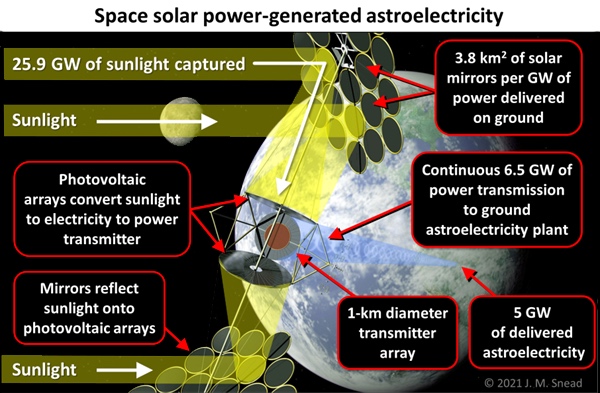 Figure 2: Space solar power-generated astroelectricity. (Original image source: US government. Modified image credit: J. M. Snead.) |
Unlike TV satellites which broadcast to an entire continent, a GEO space solar power platform would direct its transmission to a specific receiving antenna array—called an astroelectric plant—on the ground. (See Figure 3.) If located at the Equator, the array would be circular, while north or south of the Equator, the array becomes elongated as illustrated in the figure.
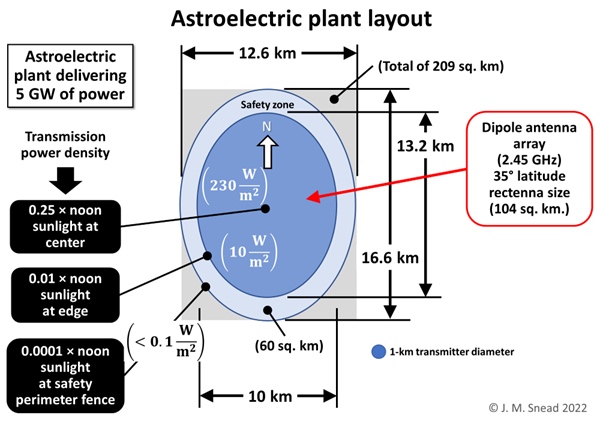 Figure 3: Astroelectric plant layout. (Image credit: J. M. Snead.) |
From a distance, the receiving array would appear similar to a solar PV farm. However, the panels would have a grid of small dipole antennas—like old-fashioned TV “rabbit ear” antennas—about six centimeters long. The electronics in each panel would convert the received radio waves into electrical power, just as any radio receiver does. The output of all the panels would be linked together such that the astroelectric plant becomes a gigawatt-scale baseload power plant capable of, for example, replacing coal-fueled power plants.
The size of the receiving array is set by the natural laws of physics governing radio transmission. Once the transmission frequency is set, the diameter of the transmitter in GEO and the East-West size of the receiving array can be determined to best meet the needs of a particular astroelectric plant location. The size of the receiving array shown in Figure 3 is based on the NASA–DOE baseline that uses a transmitted frequency of 2.45 billion cycles per second referred to as gigahertz (GHz). The baseline transmitter diameter is one kilometer.
Power transmission from GEO to the ground
Long ago, the US government allocated specific bands of frequencies for various purposes such as TV broadcasts and radar. As mentioned for the baseline design, astroelectric power is transmitted at a frequency of 2.45 GHz. This 2.45 GHz frequency falls within the band used for general industrial purposes. In part, this was due to the fact that radio waves at this frequency pass through the atmosphere with minimal power loss. This happens to be the frequency used for microwave ovens and Wi-Fi.
Due to the nature of directionally transmitted radio waves, the strength of the transmission beam is at a maximum in the center of the beam, fading away from the center. As shown in Figure 3, at the center of the receiving array, by design, the transmitted power has been limited to 230 watts per square meter. For perspective, sunlight at ground level at the Equator has a power of around 1,000 watts per square meter. This limitation on the peak power was apparently set to prevent harm to overflying birds. For comparison, inside a microwave oven, the power level is about 9,000 watts per square meter.
| With this integrated space-ground solar approach, around 291,000 square kilometers—requiring only about 4% of the contiguous US—would enable the US to fully go green by 2100 for a population of 500 million. |
At the outer edge of the array, the strength of the transmission beam falls to only 1% of the power of sunlight. At the outer edge of the safety perimeter, it would be only 0.01%, consistent with government regulations to prevent excessive public exposure. While abiding by government exposure limits for workers, humans should be able to work within the safety zone. This would enable the safety zone area to be used for cropland, industrial facilities, or solar farms.
Estimating America’s 2100 green energy needs
In Part 2, the general green energy transition model shown in Figure 4 was first introduced for use in estimating America’s green energy needs. This model is designed to enable America’s transition to green energy to be undertaken in an orderly manner that will be largely transparent to the end users. One day they could be consuming electricity and fuels provided by fossil fuels and the next by entirely green sources. Properly engineered, as the transition should be, the only difference noted during the transition would be the notation on the utility bills identifying the electricity and fuel sources as being green.
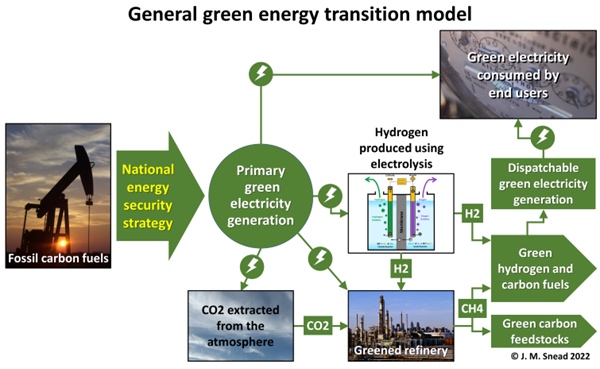 Figure 4: General green energy transition model. (Image credit: J. M. Snead.) |
In this transition model, fossil carbon fuels are replaced by primary sources of green electrical power. For simplicity in this article’s evaluation, these are assumed to be either only baseload (e.g., space solar power) or intermittent sources: wind power or ground solar power. As an all-electric green energy infrastructure is not practical, the new green energy infrastructure must be capable of producing combustible fuels. These fuels are assumed to be either hydrogen or synthetic methane. Thus, to use this model to predict America’s green energy needs, four cases have been evaluated: baseload–hydrogen or methane and intermittent–hydrogen or methane.
Estimating America’s total energy need
The government keeps extensive records of America’s energy use. Each year it reports the total amount of energy America used. This is reported using an energy unit called a barrel of oil equivalent or BOE.
In 2019, prior to the start of the pandemic, the US used 17,291,880,690 BOE of primary energy. In that year, the US Census Bureau estimated that the mid-year resident US population was 328,239,523. Thus, the average per person use of energy in America in 2019 is estimated to be 52.7 BOE.
The US had a strong economy in 2019 with low unemployment, low inflation, and low energy prices. Thus, the per person energy use in 2019 reflects good middle-class prosperity and, consequently, is an appropriate value to use for estimating future US energy needs.
Estimating America’s 2019 per person green energy need
In Part 2, the 52.7 BOE per person value was converted in an equivalent amount of primary green electrical energy needed per person using the transition model described above. The results of this conversion of green power are shown in Table 1.
 Table 1: US 2019 equivalent continuous green power per person. (Note: Computed values have been rounded to three decimal places.) |
These results are expressed as the kilowatts of equivalent continuous power or “kilowatts-continuous” abbreviated as kWc. A typical countertop microwave oven uses about one kilowatt (kW) of power when operating. If this oven were to operate continuously for the entire year, it would use 1 kWc of power. From Table 1, for the baseload–methane case, the US average per person energy use in 2019 equated to a continuous green electrical power supply of 17.4 kWc—enough to power over 17 microwave ovens continuously.
(Note: The difference between the hydrogen and methane cases is because it takes more input green electricity to produce the needed amount of fuel when using methane compared to hydrogen. For safety reasons, hydrogen is unlikely to become a commonly used fuel while green methane—and other green carbon fuels such as diesel and jet fuel—produced at greened refineries will replace the same fuels derived from fossil carbon fuels. As the production of these green carbon fuels will use carbon dioxide extracted from the atmosphere, no net additions of carbon dioxide will be made enabling this to be a “green” solution.)
Estimating America’s 2100 green energy need
As explained in Part 3, based on US Census Bureau population growth projections, the US population in 2100 was assumed to grow by around 50% to 500 million. (This forecast population growth will primarily be due to continued net international migration to the US. This means that US immigration policies are also key energy transition planning considerations.)
When this 2100 US population size of 500 million is combined with the 2019 green energy per person values from Table 1, the total US green energy needs for each of the four cases are shown in Table 2. (Note: These values are expressed using gigawatts of equivalent continuous power or “gigawatts-continuous” abbreviated GWc.) To help in appreciating the magnitude of these needs, these are also shown in terms of the number of 2-GW Hoover Dams operating continuously that would be needed. With the use of green carbon fuels, the US will need 4,350–5,546 Hoover Dams of equivalent continuous green generation capacity by 2100.
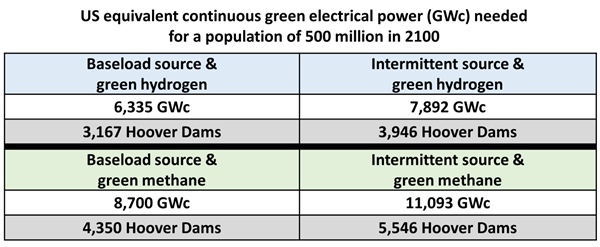 Table 2: US equivalent continuous green electrical power (GWc) needed for a population of 500 million in 2100. |
Assessing America’s use of astroelectricity
Total land needs for astroelectricity in 2100
With the technological feasibility of space solar power—the ability to transmit power to the ground—having been established 40 years ago, the primary practicability issue with using space solar power is how much land would be needed for the astroelectric plants. In Part 1, it was shown that the US currently relies on fossil fuels for about 80% of its total energy.
From Table 2, the baseload–methane case for 2100 would require 8,700 GWc to go entirely green. We will assume that space solar power will provide the 80% needed to replace fossil fuels. This will require 6,960 GWc of space solar power-generated astroelectricity. To supply this amount, 1,392 5-GW astroelectric plants will be needed by 2100.
As shown in Figure 3, for a typical American astroelectric plant, the receiving array would require 104 square kilometers of land for the oval receiving array. Thus, 1,392 astroelectric plants would require around 145,000 square kilometers of relatively flat land for the receiving arrays.
The total land area of an astroelectric plant would be the rectangular area of 12.6 × 16.6 kilometers = 209 square kilometers. Thus, the total area of all astroelectric plants would be 291,000 square kilometers for a projected US population of 500 million in 2100.
Providing an integrated space and ground solar solution for America in 2100
With astroelectricity supplying 80% of US energy needs in 2100, the remaining 20% would come from terrestrial sources. For discussion purposes, we will assume this to be provided by ground solar power.
In Part 3, it was estimated that 1.45 million square kilometers of solar farms would be required to supply 100% of the US 2100 energy needs with intermittent solar power with methane used as the fuel. We will assume that the needed 291,000 square kilometers of astroelectric plants would simultaneously be used for ground solar PV farms. Coincidently, these ground solar farms would provide the remaining 20% of the green energy needed in 2100—resulting in a 100 percent green energy solution.
| For over half a century, America has been in a holding pattern, waiting for the right combination of energy security needs and American spacefaring industrial mastery to enable America to lead the free world’s adoption of astroelectricity. |
With this integrated space-ground solar approach, around 291,000 square kilometers—requiring only about 4% of the contiguous US—would enable the US to fully go green by 2100 for a population of 500 million. As mentioned, with the technological feasibility of space solar power having been established 40 years ago, such an integrated approach should be America’s preferred practicable solution to go green when compared to the extensive land needed for wind and ground solar farms.
This finding illustrates the value of conducting proper engineering trade studies to define how America can best transition to green energy in an orderly manner. Of course, more detailed trade studies are needed to find the preferred combination of America’s green energy options. However, these initial trade studies highlight the fact that passing willy-nilly legislation to try to push America to go green often pursues poor solutions that waste time and money.
Goals for a national energy security strategy
Throughout this article, the lack of a well-organized national energy security strategy has been emphasized. Drawing on the findings developed in this article, the following four goals are proposed to guide developing such a strategy:
- Reestablish and maintain America’s domestic energy independence, including domestic fossil fuel independence, throughout America’s transition to abundant green energy.
- Complete the transition to green energy as rapidly as is consistent with maintaining America’s energy security and, at a minimum, maintaining America’s middle-class prosperity and standard of living.
- Transition America, in an orderly and largely transparent manner, to practicable green energy sources developed as a public good to permanently ensure America’s affordable energy security and prosperity.
- Undertake the transition in a “whole of the nation” manner to maximize bringing the benefit of undertaking the transition to all Americans and to prepare the United States to enter the 22nd century as a free, prosperous, energy abundant, and sustainable nation at peace.
Is such a strategy really now needed? Founded in the wake of the first oil supply crisis, the mission of the US Department of Energy is:
[T]o ensure America’s security and prosperity by addressing its energy, environmental and nuclear challenges through transformative science and technology solutions. [Emphasis added.]
Today’s American energy insecurity and green energy transition chaos indicate quite clearly that the Department of Energy needs a well-organized national energy security strategy to guide its operations to “ensure America’s security and prosperity”. The starting point is for Congress to mandate that the Department, under the direction of a registered professional engineer, develop and submit such a strategy to Congress for approval. Without such a good engineering plan, valuable time and resources are being wasted.
Conclusion
As mentioned at the beginning, anthropologist Leslie White highlighted that the formation of human civilization was founded on the domestication of animals and the cultivation of plants to harvest “solar energy in a new way and in a new form.” The need for America to transition to environmentally acceptable, sustainable (green) energy sources to replace fossil carbon fuels has been evident since the 1970s. Yet, in the ensuing half-century, little true progress towards this goal has been achieved.
A century ago, Russian space scientist, inventor, and philosopher Konstantin Eduardovich Tsiolkovsky first described the eventual need for humanity to tap the natural resources of outer space to support our growing human civilization. In 1941, in his State of the Union Address, President Franklin D. Roosevelt established “freedom from want” as a universal human right—a right now enshrined in the Universal Declaration of Human Rights that requires abundant, affordable energy per person (see “America’s moral obligation to develop astroelectricity”, The Space Review, February 14, 2022) In 1968, Peter Glaser conceived of how sunlight in the vicinity of the Earth could be tapped to provide abundant green energy on the Earth that we can now use to enable global freedom from want. In 1976, Gerard K. O’Neill forecast how humanity would need to settle the central solar system to undertake the spacefaring industrial revolution required to use Glaser’s invention to power the world. These futurists understood the tremendous benefits that becoming a true human spacefaring civilization would bring to the Earth.
This article’s quantitative findings show quite clearly that terrestrial sustainable energy sources cannot be practicably scaled up to replace fossil fuels while maintaining America’s energy security and energy-enabled prosperity. Effectively, in attempting to only use terrestrial green energy sources, America would be limited in its future sustainable development—bringing energy impoverishment and forcing a decline in America’s standard of living. Common sense says that this is not a path for America to pursue. Instead, America now needs to follow the lead of Tsiolkovsky, Glaser, and O’Neill to harvest “solar energy in a new way and in a new form” to undertake America’s transition to green energy using astroelectricity.
For over half a century, America has been in a holding pattern, waiting for the right combination of energy security needs and American spacefaring industrial mastery to enable America to lead the free world’s adoption of astroelectricity. With America’s terrestrial options for going green not providing practicable solutions, the time for America to develop space solar power-generated astroelectricity has arrived. America now needs to pursue space solar power-generated astroelectricity to ensure that our children and grandchildren enjoy an orderly, prosperous transition to green energy. Without hesitation, American must now move swiftly to become a true human spacefaring nation to undertake the spacefaring industrial revolution necessary to lead the free world in making space solar power a reality this century!
Author’s note
The quantitative information presented in this article is provided for information purposes only and is not intended to be used for any other purposes. The author believes that the information provided is accurate, consistent with the top-level nature of these analyses and the sources of information used.
Note: we are using a new commenting system, which may require you to create a new account.
